The Economics and Statistics Division maintains archives of previous publications for accountability purposes, but makes no updates to keep these documents current with the latest data revisions from Statistics Canada. As a result, information in older documents may not be accurate. Please exercise caution when referring to older documents. For the latest information and historical data, please contact the individual listed to the right.
<--- Return to Archive
For additional information relating to this article, please contact:
August 18, 2021ANALYSIS OF NOVA SCOTIA'S CONSUMER PRICE INDEX FOR JULY 2021 TRENDS – July 2021
Nova Scotia’s All-Items Consumer Price Index (CPI) increased 4.6 year-over-year in July 2021, accelerating from the 4.1% increase in June. Nationally, consumer prices were up 3.6% from a year earlier, following a 3.1% increase in June 2021.
Statistics Canada noted that the national prices accelerated in six of the eight major components and shelter prices contributed the most to the overall increase. The homeowners' replacement cost index increased 13.8% compared to July 2020 - the largest yearly increase since October 1987. Durable good inflation accelerated with notable increases in passenger vehicle indexes, upholstered furniture (tariffs introduced on Vietnam and China in May 2021), and video equipment. Year-over-year gasoline prices slowed from 32.0% in June to 30.9% in July as month-over-month prices were up 3.5% as oil production by OPEC+ continues to be below pre-pandemic levels while global demand has increased. Price growth for clothing and footwear and alcoholic beverages, tobacco products and recreational cannabis slowed.
Impact of COVID-19 on the Consumer Price Index
Statistics Canada continued special CPI program measures for July 2021. Due to COVID-19 impact on product availability, select sub-components of the CPI received temporary special imputations. The sub-indexes for travel tours, some components of spectator entertainment, recreational services, and some components of use of recreational facilities and services in some areas were imputed from the monthly change in the all-items index - effectively removing the impact of these goods and services on the CPI.
All provinces had higher year-over-year inflation in July than June. Inflation was led by Prince Edward Island (+6.1%). Saskatchewan had the slowest growth (+2.3%).Compared to the previous month, all provinces had increases in the CPI index in July 2021.
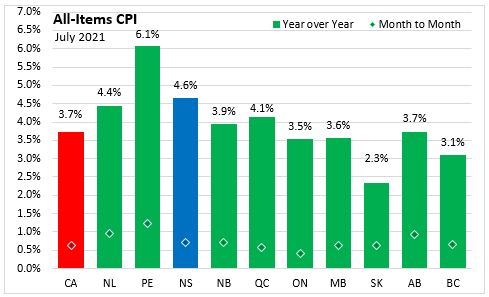
The main contributors to the monthly change (July 2021 vs June 2021) in Nova Scotia CPI were:
- Gasoline (+4.8%)
- Rent (+1.9%)
- Personal care supplies and equipment (4.5%)
- Children's clothing (-6.9%)
- Dairy products (-1.7%)
- Other food preparations (NA)
The main contributors to the yearly change (July 2021 vs July 2020) in Nova Scotia CPI were:
- Gasoline (+40.5%)
- Fuel oil and other fuels (+37.9%)
- Homeowners’ replacement cost (+15.6%)
- Telephone services (-14.0%)
- Mortgage interest cost (NA)
- Recreational equipment and services (excluding recreational vehicles) (-3.7%)
Nova Scotia’s consumer price inflation (year-over-year) excluding food and energy increased 3.1% in July 2021. Consumer prices excluding food and energy were up in all provinces led by Prince Edward Island (+4.0%) and Quebec (+3.8%). Saskatchewan had the smallest increase at 1.4%.
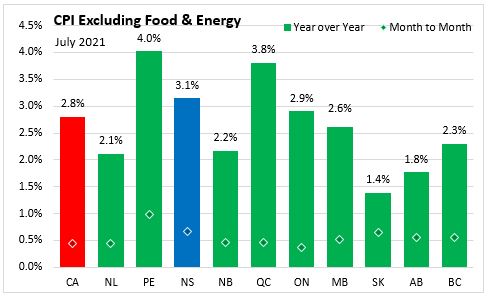
The CPI for food in Nova Scotia increased 1.8% year-over-year in July 2021. Nationally, food prices were up 1.7% from a year earlier. All provinces recorded year-over-year increase in food prices led by Newfoundland and Labrador (+2.9%). Manitoba had the lowest increase at 0.7%.
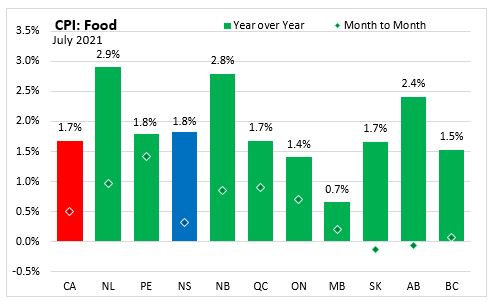
Nova Scotia energy prices increased 24.8% year-over-year in July 2021 compared to the national average of 19.7%. All provinces reported double digit increases in energy prices. The year-over-year change in Nova Scotia’s and other Atlantic provinces' CPI is more exposed to the effects of changes in oil prices on inflation due to a larger use of fuel as a source of home heating compared to other provinces.
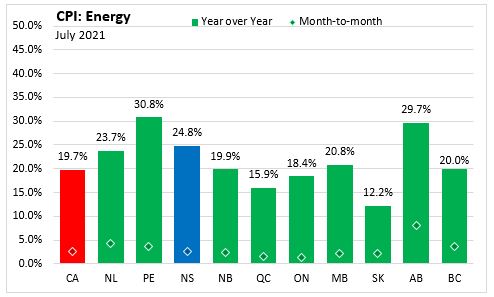
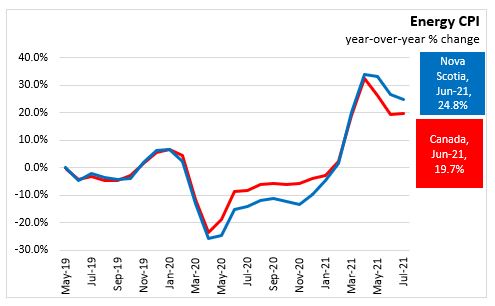
Year-over-year, shelter costs in Nova Scotia increased 6.3% in July 2021, above the national average increase of 4.8%. Compared to July 2020, shelter prices were up in all provinces with the largest increase in Prince Edward Island (+10.8%) and the smallest increase in Saskatchewan (+1.0%).
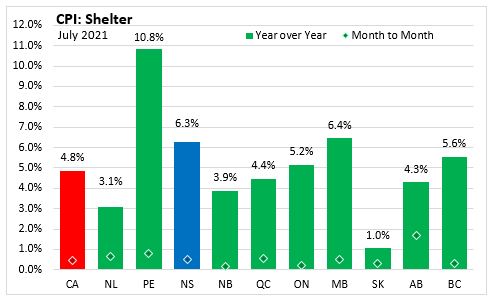
Nova Scotia's consumer price inflation (year-over-year growth in CPI) excluding energy was 3.0% in July compared to a national rate of 2.6%. Prince Edward Island (+3.5%) posted the largest year-over-year gain while the CPI excluding energy had the smallest change in Saskatchewan (+1.5%).

Major Components for July 2021
The following table shows the price increases specific to Nova Scotia for the major components of the CPI this month:
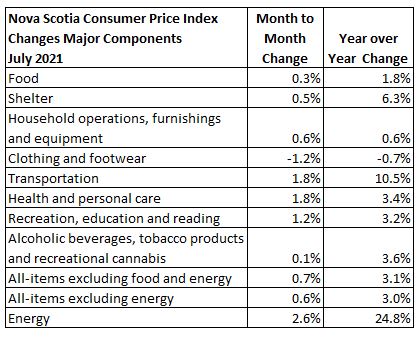
Long Run Trends
In July 2021, the All-Items CPI year-over-year inflation rate for Nova Scotia was 4.6%, above Canada's average rate at 3.7%. Month-to-month movements in the indices can be different, over time they generally follow the same overall trend. Nova Scotia’s all-items CPI increase of 4.8% in May 2021 was the largest increase since March 2003 (+6.9%).
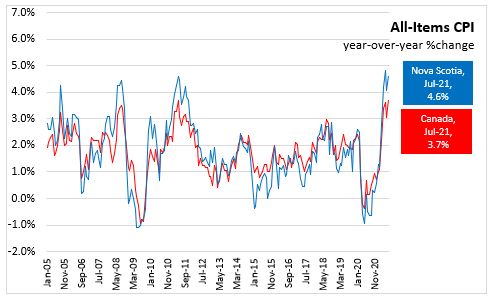
Nova Scotia’s all-items CPI excluding food and energy increase of 3.1%, increasing 1 percentage point from the 2.1% increase the previous month. Canada CPI excluding food and energy had a smaller increase rising from 2.2% to 2.8%.
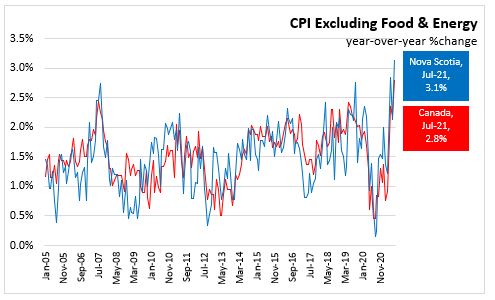
Bank of Canada's preferred measures of core inflation
Compared to July 2020, CPI-Common increased 1.7%, CPI-Median increased 2.6% and CPI-Trim was up 3.1% in Canada. All-items CPI excluding eight of the most volatile components as defined by the Bank of Canada and excluding the effect of changes in indirect taxes (formerly referred to as CPIX), rose 3.3% year-over-year. The change in the core inflation measures were unchanged for CPI-common, up 0.2 percentage point for CPI-median and up 0.4 for CPI-trim.

Appendix Tables and Charts
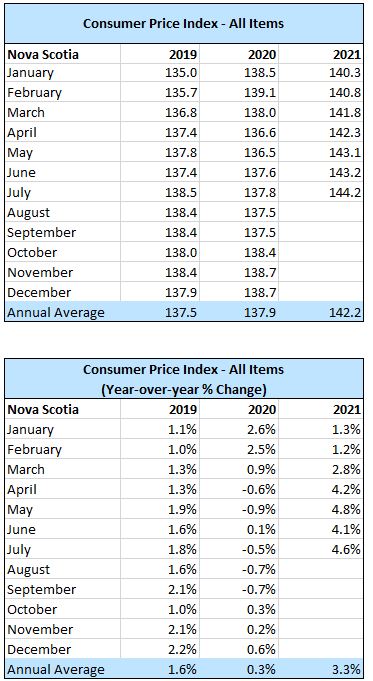
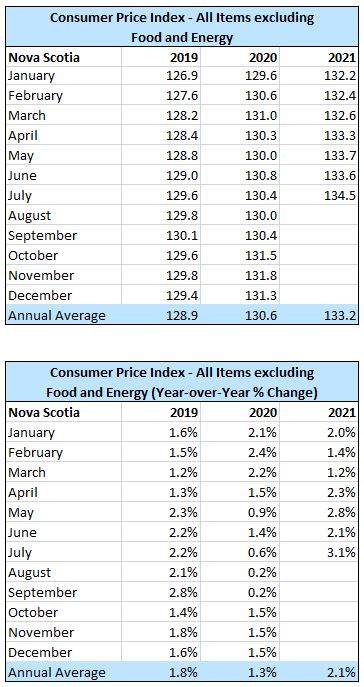
Basket Update
With the June 2020 release the CPI basket of goods and services has been updated. The new basket weights are based on 2020 expenditure data, in which spending would reflect pre-pandemic patterns (Jan-Feb), an economy mostly in lockdown (March-June), and the emergence of new consumption patterns as economy re-opened (July-December). Statistics Canada notes that the "The data reflect shifts in spending due to the COVID-19 pandemic that will likely take some time to stabilize across goods and services, and geographic regions" and the June 2021 headline CPI for Canada would be the same if the previous basket weights (2017) were used. The weights for shelter (+2.86 percentage points), households operations, furnishings and equipment (+2.23 percentage points), and alcoholic beverages, tobacco products and recreational cannabis (+1.7 percentage points) are higher in the 2020 basket while transportation had the largest decline falling from a 19.72% share to 15.34% share. New products classes were added for shipping fees and local delivery fees (including restaurant and grocery delivery fees), digital subscriptions services to magazines, and video game consoles. Further information on the update can be found in An Analysis of the 2021 Consumer Price Index Basket Update, Based on 2020 Expenditures
Source: Statistics Canada. Table 18-10-0004-01 Consumer Price Index, monthly, not seasonally adjusted; Table 18-10-0256-01 Consumer Price Index (CPI) statistics, measures of core inflation and other related statistics - Bank of Canada definitions
<--- Return to Archive